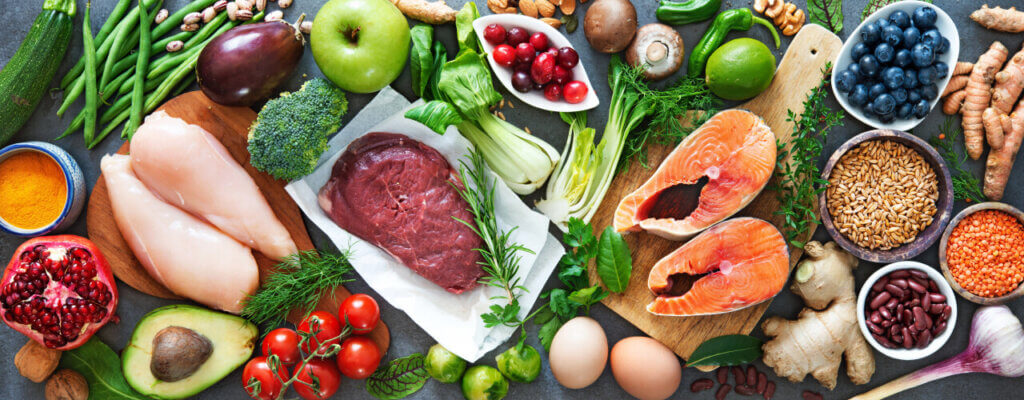When people claim they want to change their diet, they are often motivated by weight loss, allergy avoidance, muscle gain, skin improvement, or athletic performance enhancement. “I want to improve my diet to alleviate my chronic pain” is something we don’t hear quite as much when it comes to motivation!
The truth is, making some easy dietary changes will help your pain. If you would like to make an appointment with a physical therapist who will help you start living without pain, call our offices now. Until then, continue reading to learn about what kind of foods you can enjoy with physical therapy which might maximize your performance.
How are nutrition, pain, and inflammation related to each other?
Inflammation is your body’s way of alerting you to an injury or illness. Think of it as the warning signals from your immune system to initiate an attack against a possible threat. It can happen as the result of bacteria, a virus, splinters, sprained ankles, or any number of other problems.
An inflammatory response is natural, stable, and advantageous in the short term. But if inflammation lasts a long time, the immune system will begin to break down, damage tissues and organs, speed up cell aging, and increase the risk of chronic health conditions.
Chronic inflammation is linked to heart disease, cancer, obesity, osteoarthritis, and autoimmune disorders (in which the immune system attacks the cells and tissues of the body).
Can you think of another inflammation-associated condition? You guessed it: chronic pain.
Here’s where nutrition comes into play.
If your inflammation increases, your pain can get worse. By reducing or controlling inflammation, oftentimes people see significant improvements in their pain level. A growing body of research shows certain foods and beverages increase inflammation in the body, while other foods reduce inflammation in the body. This is the key mechanism by which nutrition can influence pain.
You might be curious as to how foods promote inflammation. Foods that tend to promote inflammation can do so in several ways:
- They can increase the amount of free radicals in the body, which are unstable molecules associated with a damaging process called oxidative stress (sometimes compared to the process of rusting on metal)
- They often are created with artificial ingredients, preservatives, and fillers (in addition to promoting an inflammatory response, these chemicals may irritate friendly gut bacteria in the digestive system, which can negatively affect metabolism, nutrient absorption, and even mood)
- They may rapidly spike blood sugar levels
- They often lack the micronutrients necessary for building healthy tissues and supporting key physiological processes in the body
- Certain foods may trigger allergic reactions that can be harmful
Obesity and chronic pain
Foods that tend to reduce inflammation in the body generally have the opposite effect. They don’t usually spike blood sugars quite as high or as quickly. They tend to be minimally processed and made with whole ingredients. These foods are typically rich in micronutrients, such as vitamins, minerals, antioxidants, and enzymes that fight oxidative stress, reduce inflammation, provide the raw material needed to make healthy tissues and cells.
They also tend to be relatively lower in calories but higher in fiber, which helps combat obesity.
Interestingly, research also shows that excessive fat cells in the body release inflammatory compounds. With this in mind, any type of diet or eating pattern that promotes weight gain and obesity can be considered to promote chronic inflammation. This is a major reason why obesity is a leading risk factor for chronic pain.
What are the best foods to eat (and avoid!) to reduce inflammation?
Avoid foods that promote inflammation, which include highly-processed goods, sugar-sweetened beverages, alcohol, and processed meats.
According to the Arthritis Foundation, some of the top inflammatory foods to avoid include:
- Trans fat: this is a type of fat made in a laboratory and is often added to junk food. Fortunately, trans fats are banned in the United States, but they still may be used in other countries.
- Refined sugar: this includes table sugar and high fructose corn syrup, both of which are added to everything from ketchup and salad dressings to canned goods.
- Aspartame: This is a non-nutritive sweetener that is typically found in things like diet soda. Research on aspartame’s effect on the human body is mixed, but some people’s immune systems may see these artificial sweeteners as “foreign substances” and therefore launch an inflammatory response against them.
- Omega-6 fatty acids: the standard American diet contains too many omega-6 fatty acids (found in things like corn, sunflower, safflower, soybean, and sesame oils) relative to omega-3 fatty acids (found in things like fatty fish and olive oil). This imbalance of omega 6 to omega 3 fatty acids is shown to be inflammatory.
- Refined carbohydrates: this includes most breads, pastas, cereals, crackers, chips, and other snacks, which tend to be higher on the glycemic index (a scale that measures how quickly a food raises blood sugar). Many also contain gluten, a protein that triggers an inflammatory response in some people, including those with celiac disease.
- Mono-sodium glutamate (MSG): This additive is often found in fast foods and other prepared meals.
- Dairy: Sometimes dairy products like milk, cheese, and yogurt are problematic for a person, due to a sugar called lactose and a protein called casein. Dairy products are also often high in saturated fat and dense in calories, which may further promote inflammation and weight gain. Cutting dairy out can significantly decrease pain and inflammation.
It’s important to make sure the majority of your diet consists of whole, natural, and minimally processed foods that are anti-inflammatory and rich in nutrients, including:
- Nuts and seeds
- Olive oil
- Fresh or frozen vegetables and fruits (canned is okay, too—just watch for additives)
- Complex carbohydrates like legumes and whole grains
- Quality protein sources including chicken, fish, shellfish, lean meats, eggs, and beans
- Fermented foods that contain gut-health probiotics, like kimchi, tempeh, and sauerkraut
Also, make sure to stay well-hydrated and practice other complementary lifestyle habits like daily exercise, stress reduction, good hygiene, and injury prevention strategies.
Ready to learn how your physical therapy treatment can be enhanced?
Our physical therapists are happy to discuss lifestyle and diet interventions as a way to optimize your physical therapy outcomes and can refer you to other specialists who can help you develop a pain-free diet.
Contact our physical therapy office today to schedule an appointment with a physical therapist and get back in control of your pain.
Sources:
- https://www.ncbi.nlm.nih.gov/books/NBK279298/
- https://www.hsph.harvard.edu/news/hsph-in-the-news/us-bans-artificial-trans-fats/
- https://www.healthline.com/health/oxidative-stress#effects
- https://www.hss.edu/condition-list_inflammatory-disorders.asp
- https://www.todaysdietitian.com/newarchives/1019p38.shtml
- https://www.sciencedaily.com/releases/2014/08/140825084836.htm
- https://www.arthritis.org/health-wellness/healthy-living/nutrition/healthy-eating/dairy-and-inflammation
- Adipose Tissue in Obesity-Related Inflammation and Insulin …www.ncbi.nlm.nih.gov › pmc › articles › PMC3881510
- https://www.arthritis.org/health-wellness/healthy-living/nutrition/foods-to-limit/8-food-ingredients-that-can-cause-inflammation


